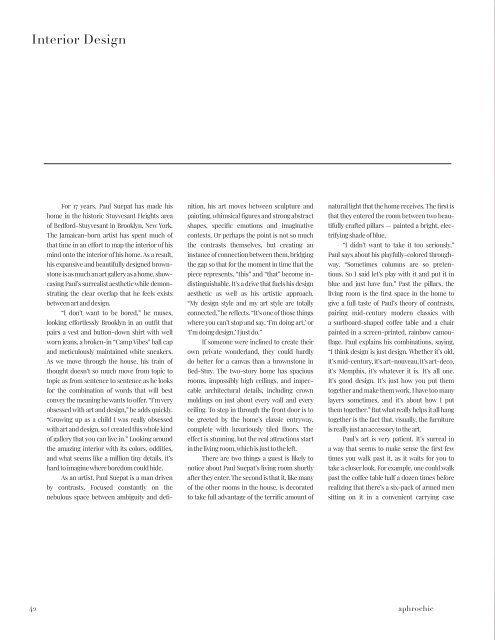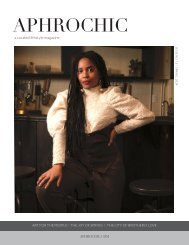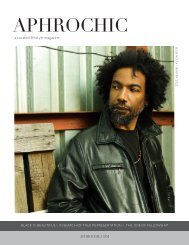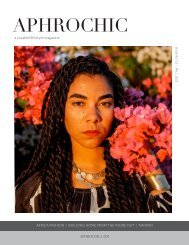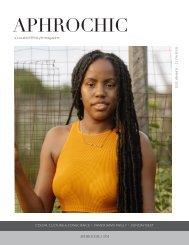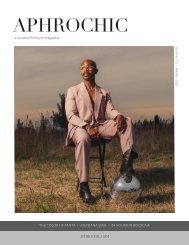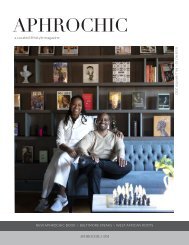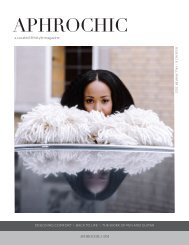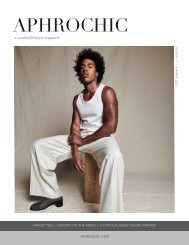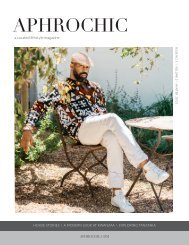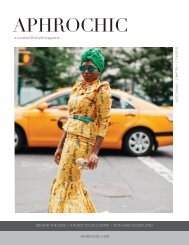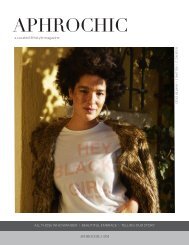AphroChic Magazine: Issue No. 4
In this issue, we sit down with artist, Malik Roberts, who relates the experience of creating one of the few African American artworks to sit permanently in the Vatican collection. Fashion designer, Prajjé Oscar John-Baptiste introduces his latest collection — an ode to Haiti, and its goddesses. We head to South Carolina to experience the Gullah-inspired music of Ranky Tanky. And in New York, we watch a new world being born with photographer and journalist, Naeem Douglass, who takes us inside the city’s Black Lives Matter protests, and economist Janelle Jones, who reminds us in these times that we are the economy. We are thrilled to share our cover with chef and musician, Lazarus Lynch. Inside, we talk with him about his cookbook, Son of a Southern Chef and his new album, I’m Gay. From a house tour in Brooklyn to a travel piece in Tobago, this issue takes you all over the Diaspora. And we see how of the concept of Diaspora was first introduced in a look back at how Pan-Africanism led the way to how we think of international Blackness today. It is a showcase of our culture, our creativity, our resilience, and our diversity, our demands for the present and our hopes for the future. Welcome to our summer issue.
In this issue, we sit down with artist, Malik Roberts, who relates the experience of creating one of the few African American artworks to sit permanently in the Vatican collection. Fashion designer, Prajjé Oscar John-Baptiste introduces his latest collection — an ode to Haiti, and its goddesses. We head to South Carolina to experience the Gullah-inspired music of Ranky Tanky. And in New York, we watch a new world being born with photographer and journalist, Naeem Douglass, who takes us inside the city’s Black Lives Matter protests, and economist Janelle Jones, who reminds us in these times that we are the economy.
We are thrilled to share our cover with chef and musician, Lazarus Lynch. Inside, we talk with him about his cookbook, Son of a Southern Chef and his new album, I’m Gay.
From a house tour in Brooklyn to a travel piece in Tobago, this issue takes you all over the Diaspora. And we see how of the concept of Diaspora was first introduced in a look back at how Pan-Africanism led the way to how we think of international Blackness today. It is a showcase of our culture, our creativity, our resilience, and our diversity, our demands for the present and our hopes for the future. Welcome to our summer issue.
You also want an ePaper? Increase the reach of your titles
YUMPU automatically turns print PDFs into web optimized ePapers that Google loves.
Interior Design<br />
For 17 years, Paul Suepat has made his<br />
home in the historic Stuyvesant Heights area<br />
of Bedford-Stuyvesant in Brooklyn, New York.<br />
The Jamaican-born artist has spent much of<br />
that time in an effort to map the interior of his<br />
mind onto the interior of his home. As a result,<br />
his expansive and beautifully designed brownstone<br />
is as much an art gallery as a home, showcasing<br />
Paul’s surrealist aesthetic while demonstrating<br />
the clear overlap that he feels exists<br />
between art and design.<br />
“I don’t want to be bored,” he muses,<br />
looking effortlessly Brooklyn in an outfit that<br />
pairs a vest and button-down shirt with well<br />
worn jeans, a broken-in “Camp Vibes” ball cap<br />
and meticulously maintained white sneakers.<br />
As we move through the house, his train of<br />
thought doesn’t so much move from topic to<br />
topic as from sentence to sentence as he looks<br />
for the combination of words that will best<br />
convey the meaning he wants to offer. “I’m very<br />
obsessed with art and design,” he adds quickly.<br />
“Growing up as a child I was really obsessed<br />
with art and design, so I created this whole kind<br />
of gallery that you can live in.” Looking around<br />
the amazing interior with its colors, oddities,<br />
and what seems like a million tiny details, it’s<br />
hard to imagine where boredom could hide.<br />
As an artist, Paul Suepat is a man driven<br />
by contrasts. Focused constantly on the<br />
nebulous space between ambiguity and definition,<br />
his art moves between sculpture and<br />
painting, whimsical figures and strong abstract<br />
shapes, specific emotions and imaginative<br />
contexts. Or perhaps the point is not so much<br />
the contrasts themselves, but creating an<br />
instance of connection between them, bridging<br />
the gap so that for the moment in time that the<br />
piece represents, “this” and “that” become indistinguishable.<br />
It’s a drive that fuels his design<br />
aesthetic as well as his artistic approach.<br />
“My design style and my art style are totally<br />
connected,” he reflects. “It’s one of those things<br />
where you can’t stop and say, ‘I’m doing art,’ or<br />
‘I’m doing design.’ I just do.”<br />
If someone were inclined to create their<br />
own private wonderland, they could hardly<br />
do better for a canvas than a brownstone in<br />
Bed-Stuy. The two-story home has spacious<br />
rooms, impossibly high ceilings, and impeccable<br />
architectural details, including crown<br />
moldings on just about every wall and every<br />
ceiling. To step in through the front door is to<br />
be greeted by the home’s classic entryway,<br />
complete with luxuriously tiled floors. The<br />
effect is stunning, but the real attractions start<br />
in the living room, which is just to the left.<br />
There are two things a guest is likely to<br />
notice about Paul Suepat’s living room shortly<br />
after they enter. The second is that it, like many<br />
of the other rooms in the house, is decorated<br />
to take full advantage of the terrific amount of<br />
natural light that the home receives. The first is<br />
that they entered the room between two beautifully<br />
crafted pillars — painted a bright, electrifying<br />
shade of blue.<br />
“I didn’t want to take it too seriously,”<br />
Paul says about his playfully-colored throughway.<br />
“Sometimes columns are so pretentious.<br />
So I said let’s play with it and put it in<br />
blue and just have fun.” Past the pillars, the<br />
living room is the first space in the home to<br />
give a full taste of Paul’s theory of contrasts,<br />
pairing mid-century modern classics with<br />
a surfboard-shaped coffee table and a chair<br />
painted in a screen-printed, rainbow camouflage.<br />
Paul explains his combinations, saying,<br />
“I think design is just design. Whether it’s old,<br />
it’s mid-century, it’s art-nouveau, it’s art-deco,<br />
it’s Memphis, it’s whatever it is. It’s all one.<br />
It’s good design. It’s just how you put them<br />
together and make them work. I have too many<br />
layers sometimes, and it’s about how I put<br />
them together.” But what really helps it all hang<br />
together is the fact that, visually, the furniture<br />
is really just an accessory to the art.<br />
Paul’s art is very patient. It’s surreal in<br />
a way that seems to make sense the first few<br />
times you walk past it, as it waits for you to<br />
take a closer look. For example, one could walk<br />
past the coffee table half a dozen times before<br />
realizing that there’s a six-pack of armed men<br />
sitting on it in a convenient carrying case<br />
42 aphrochic


